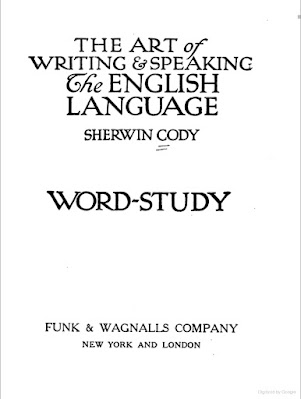The Art of Writing and Speaking the English Language
Word-Study
Vol,1
by Sherwin Cody
CONTENTS.
GENERAL INTRODUCTION
WORD-STUDY
INTRODUCTION — THE STUDY OF SPELLING
CHAPTER I. LETTERS AND SOUNDS
{VOWELS CONSONANTS EXERCISES THE DICTIONARY}
CHAPTER II. WORD-BUILDING {PREFIXES}
CHAPTER III. WORD-BUILDING — Rules and Applications {EXCEPTIONS}
CHAPTER IV. PRONUNCIATION
CHAPTER V. A SPELLING DRILL
APPENDIX
Description
Excerpt from The Art of Writing and Speaking the English Language, Vol. 1: Word-Study
The spelling problem is not to learn how to spell nine tenths of our words correctly. Nearly all of us can and do accomplish that. The good speller must spell nine hundred and ninety-nine one thousandths of his word correctly, which is quite another matter. Some of us go even one figure higher.
Also see:
[v. 1] Word-Study
[v . 2] Grammar & Punctuation
[v . 3] Composition & Rhetoric
[v . 4] Constructive Rhetoric
[v . 5] Story Writing & Journalism
[v . 6] How To Read And What To Read
About the Author
Alpheus Sherwin Cody
(November 30, 1868 – April 4, 1959) was an American writer and
entrepreneur who developed a long-running home-study course in speaking
and writing and a signature series of advertisements asking “Do You Make
These Mistakes in English?” A critic of traditional English education,
Cody advocated colloquial style and grammar. His course, presented in a
patented workbook format which he described as self-correcting, was
purchased by over 150,000 students from its inception in 1918. He
published essays, books and articles virtually nonstop from 1893 through
1950. In a book published in 1895, he gave the advice, "Write what you
know—so go out and know something." Wikipedia
Buy Sherwin Cody Books at Amazon
The PDF might take a minute to load. Or, click to download PDF.
If your Web browser is not configured to display PDF files. No worries, just click here to download the PDF file.



.jpg)
No comments:
Post a Comment